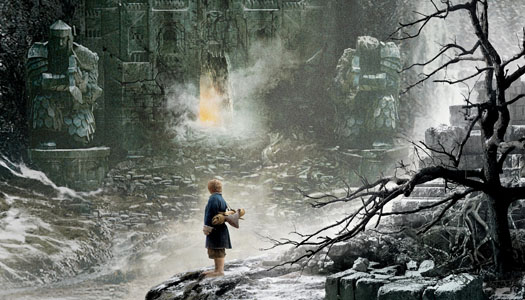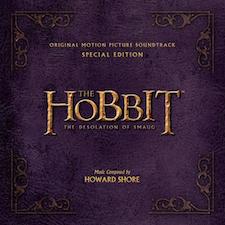
 BUY FROM AMAZON: CLICK HERE!
BUY FROM AMAZON: CLICK HERE!
MSRP $19.98
LABEL Watertower Music
RUNNING TIME 129 Minutes
The Lowdown
I really wish I had liked The Desolation of Smaug. Being an enthusiastic fan of Jackson’s Rings Trilogy, I so desperately wanted a step up from my slight disappointment with An Unexpected Journey. No such luck, though. To me, The Desolation of Smaug felt like forty minutes of compelling fantasy and two hours of needless dawdling. There’s a shitload of spectacle, though, so while there is a lot of wheel-spinning, at least the wheels are really big. While I found it to be a pretty joyless experience (sorry, Nick), I felt I needed to see the film to review the soundtrack, as Howard Shore has introduced a few new leitmotifs that I needed to hear within the context of the film.

When it comes to crafting catchy leitmotifs, Shore is a master. I am still in awe of how many instantly recognizable themes he created for The Lord of the Rings. There were several new themes and recurring motifs introduced in The Hobbit: An Unexpected Journey, but the Misty Mountains theme was by far the most recognizable. Imagine my surprise when I learned that Howard Shore had no hand in writing it. It was in fact written by Plan 9, a New Zealand composers’ collective. Shore skillfully wove their melody into his own score, and it became the most memorable theme in the film, the equivalent of the Fellowship theme from the first trilogy.
For some unknown reason, the Misty Mountains theme makes no appearance in The Desolation of Smaug, and is thus absent from the soundtrack. Its presence is sorely missed. There are other motifs used to represent the dwarves, but none of them are very recognizable. The Bilbo/Frodo/Shire theme pops up a handful of times throughout the film, and it’s refreshing when that solo clarinet comes through, reminding us of the comfort of films past. But since Bilbo’s presence seems reduced in the film, it’s a rarity. Also making a welcome reappearance is the longing Ring theme, as we start to feel Bilbo’s growing attachment to The Ring.
The dwarves’ imprisonment in Thranduil’s Mirkwood halls is one of the strongest and best-looking sequences in the film, and it also happens to feature some of the better music in the score. The Woodland Realm opens strongly, leading into a cue that is very evocative of the Lothlorien theme from Fellowship. Also appearing in this section of the film is one of the strongest new leitmotifs introduced in The Desolation of Smaug: the Tauriel/Legolas battle theme. It’s a heroic elven melody that shows up whenever Orlando Bloom and Evangeline Lilly are kicking ass, heard most prominently in the tracks Flies and Spiders and The Forest River. Love interest Tauriel gets her own romantic theme when she’s flirting with Kili, and it’s strongly reminiscent of the music used for Arwen in The Lord of the Rings. First heard in the track Feast of Starlight, Tauriel’s theme uses heavenly choral textures and longing strings under crystalline flute and oboe solos, which leads into a boy’s vocal solo. Shore has always made good use of young voices, and it’s good to hear that trend continue.
Another fantastic addition to the leitmotifs of Middle Earth is the Lake-town theme, first heard in Thrice Welcome, the first track on the second disc. It’s a sound so distinctly different from anything we’ve heard before in Middle Earth, bringing to mind a medieval folk tune. There’s also some well-placed, subtle use of harpsichord as we’re introduced to Stephen Fry’s grotesque Master of Lake-town. We hear the Lake-town theme used again in Durin’s Folk, as our dwarven troupe gets settled to their new surroundings. Meanwhile, Gandalf begins to unravel the mystery of The Necromancer, and we start to hear more stirrings of the Sauron theme.
Bits and pieces of Sauron are woven throughout the entire score, frequently implying his presence. We don’t hear Sauron’s full theme appear until A Spell of Concealment, in which The Enemy finally reveals himself to Gandalf. Bass trombones blast under shrieking violins, while trumpets take the melody. It’s terrific stuff, and one of the few places that Shore lets himself go full-on horror. Sauron’s influence is later implied in Smaug’s motif, which follows a similar (albeit simpler) melody. This is a brilliant bit of composition, telling us that The Enemy’s influence has reached Smaug, and that the two are potentially allied. The dragon even mentions that a greater threat is coming to Middle-earth, further reinforcing a connection between them. This connection is an interesting idea, but not exactly canon. It kind of strips Smaug of his autonomy, making him seem like just an extension of Sauron. Despite this, Smaug’s famous scenes with Bilbo are the best scenes in the film, and they are accompanied by some of the coolest music Shore has ever composed for Middle-earth.
As I said before, Smaug’s simple motif is familiar, following the basic template of Sauron’s theme. But that’s not the most interesting thing going on while Bilbo is in Smaug’s lair. Beginning in the track The Courage of Hobbits and recurring frequently until the end of the soundtrack, Shore employs some previously unheard ethnic percussion. I can’t identify the instruments exactly, but they sound like Indonesian gamelan, which employs tuned gongs and other unique, xylophone-like instruments. It makes Smaug feel foreign, like a remnant from another world. Also used to great effect are finger cymbals, adding a light ching-ching-ching, like the clinking of ancient riches underfoot. It all adds up to a goosebump-inducing atmosphere, and sounds unlike anything else in Shore’s immense body of work.
These new elements are rich and satisfying additions to the music of Middle-earth, and they might just be my favorite things in The Desolation of Smaug. But much like the film, the soundtrack spends a lot of time spinning its wheels, particularly in the first disc. There’s a lot of plodding, dark, oppressive, and thematically uninteresting music. Things don’t get very substantial until the dwarves encounter the spiders in Mirkwood. On this special edition, the many extended tracks don’t add much meat, just more filler. Luckily, there’s less filler on the second disc, which contains all the amazing Smaug stuff. Also on the second disc is the obligatory pop-singer-end-credits song, I See Fire. Written and performed by young English singer-songwriter Ed Sheeran, I See Fire is much more pleasant than Neil Finn’s Song of the Lonely Mountain from the previous film. It’s got a hooky, finger-picked acoustic guitar part under Sheeran’s subdued vocals, which escalate to a soulful set of choruses near the end. It’s an uplifting way to end the soundtrack, which is filled with so much trudging through the dark.
A few final notes for The Desolation of Smaug: this score was performed by the New Zealand Symphony Orchestra, unlike the previous Hobbit score which was performed by the renowned London Philharmonic. I was unable to discern any major difference, and I think New Zealand Symphony orchestra performed just as well, if not better. I hope they come back for the third Hobbit film. It should also be noted that for the first time in a long time, Shore wasn’t able to conduct the orchestra during recording, and several talented orchestrators were employed to accomplish the enormous task of finishing this score. None of this affects the score negatively.
While casual listeners may want to go for the standard edition, this special edition is a must-have for the ultra-mega-fan. The true music geek should forgo the digital version and spring the physical package, which includes some cool interactive sheet music and great liner notes.
Standout Tracks
Disc One:
- Flies and Spiders (Extended Version)
- The Woodland Realm (Extended Version)
- Feast of Starlight
Disc Two:
- A Spell of Concealment (Extended Version)
- On the Doorstep
- The Courage of Hobbits
- Inside Information
- The Hunters (Extended Version)
- I See Fire
Rating: 




Out of a Possible 5 Stars